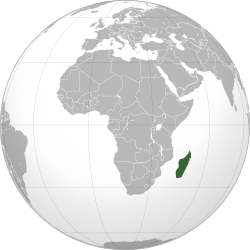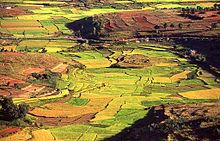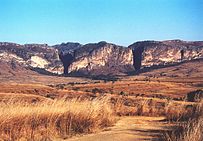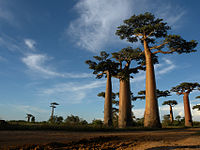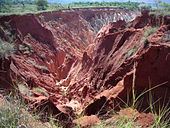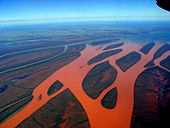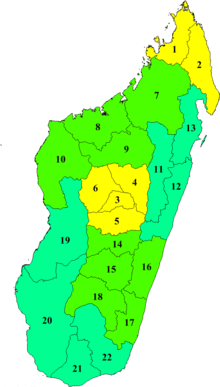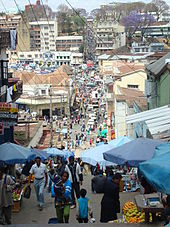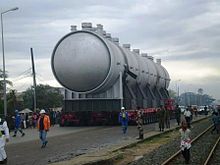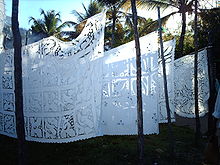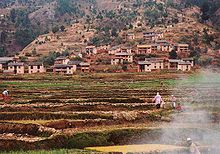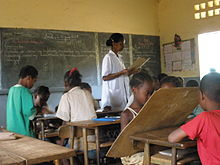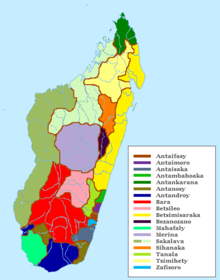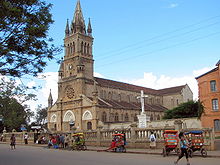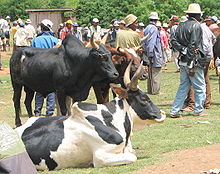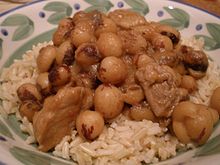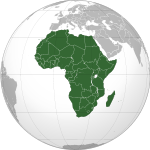- Madagascar
-
Republic of Madagascar
Repoblikan'i Madagasikara
République de Madagascar

Flag Seal Motto: Fitiavana, Tanindrazana, Fandrosoana (Malagasy)
Amour, patrie, progrès (French)
"Love, Fatherland, Progress"[1]Anthem: "Ry Tanindrazanay malala ô!"
Oh, Beloved Land of our Ancestors!
Location of MadagascarCapital
(and largest city)Antananarivo
18°55′S 47°31′E / 18.917°S 47.517°EOfficial language(s) Malagasy, French Demonym Malagasy[2] Government Caretaker government - President of the High Transitional Authority Andry Rajoelina - Prime Minister Omer Beriziky[3] Independence from France - Date June 26, 1960 Area - Total 587,041 km2 (47th)
226,597 sq mi- Water (%) 0.009% Population - 2011[4] estimate 21,926,221 (53rd) - 1993 census 12,238,914 - Density 35.2/km2 (174th)
91.1/sq miGDP (PPP) 2010 estimate - Total $19.49 billion - Per capita $990 GDP (nominal) 2010[5] estimate - Total $8.59 billion - Per capita $320 Gini (2001) 47.5 (high) HDI (2010)  0.435 (low) (135th)
0.435 (low) (135th)Currency Malagasy ariary ( MGA[4])Time zone EAT (UTC+3) - Summer (DST) not observed[6] (UTC+3) Drives on the right ISO 3166 code MG Internet TLD .mg Calling code +261[6] The Republic of Madagascar (older name Malagasy Republic, Malagasy: Repoblikan'i Madagasikara [republiˈkʲan madaɡasˈkʲarə̥], French: République de Madagascar) is an island country located in the Indian Ocean off the southeastern coast of Africa. The nation comprises the island of Madagascar (at 587,041 square kilometres (226,658 sq mi), the fourth-largest island in the world), as well as numerous smaller peripheral islands, the largest of which include Nosy Be and Nosy Boraha (Île Sainte-Marie).
The prehistoric breakup of the Gondwana supercontinent separated the Madagascar-Antarctica-India landmass from the Africa-South America landmass around 135 million years ago. Madagascar later split from India around 88 million years ago, allowing plants and animals on the island to evolve in complete isolation. Consequently, Madagascar is a biodiversity hotspot in which over 80% of its plant and animal species are found nowhere else on Earth. These are dispersed across a variety of ecoregions, broadly divided into eastern and south-central rain forest, western dry forests, southern desert and spiny forest. The island's diverse ecosystems and unique wildlife are severely threatened by human settlement and traditional slash-and-burn practices (tavy) which have denuded Madagascar of as much as 90% of its original forest cover. Under the administration of former President Marc Ravalomanana, the government of Madagascar partnered with the international community to implement large-scale conservation measures tied to ecotourism as part of the national development strategy. However, under Rajoelina's caretaker government there has been a dramatic increase in illegal logging of precious woods and the poaching and sale of threatened species such as lemurs in Madagascar's many national parks, several of which are classified as UNESCO World Heritage Sites.
Most researchers believe Madagascar was first inhabited sometime between 300 BCE and 500 CE by Austronesian peoples arriving on outrigger canoes from Borneo in the Indonesian archipelago who were later joined around 1000 CE by Bantu migrants crossing the Mozambique Channel and establishing first on the North and West coasts. Arabs, East African, later Malay and Javanese, Indians, Chinese and European (primarily French) migrants settled on Madagascar over time, each one making lasting contributions to Malagasy cultural life. The Malagasy ethnic group is often sub-divided into sixteen or more sub-groups of which the largest are the Merina of the central highlands around Antananarivo, and the Betsimisaraka people of the eastern coast around Toamasina. The Austronesian origins of the earliest population are evident everywhere not only in the language and the physical appearance of many Malagasy people, but also in cultural practices related to the veneration of ancestors, the prevalence of : the valiha (a bamboo tube zither of East Asian origin) and the sodina flute in Malagasy musical traditions, the architectural methods and norms who share the same norms than in South East Asia (like the square foundations of habitations), and a cuisine based on rice that establishes the Malagasy people as the largest rice consumers per capita in the world. Bantu influences are evident - especially in the West coast and in the South - in the spiritual and monetary value placed on zebu.
The first transcription of Malagasy using Arabic script (sorabe) and certain elements of Malagasy cosmology were introduced ca 1500 by Arabs, and islamised Indians and Indonesian people who were established on the Southeast coast (in the current Vohipeno and Manakara region).
Malagasy, the Austronesian language spoken in various forms by the vast majority of the population, is the national language and one of two current official languages alongside French and English. The majority of the population adheres to traditional beliefs or Christianity, but followers of other faiths such as Islam and Hinduism are found in smaller numbers throughout the country.
Until the late 18th century, the island of Madagascar was populated by a fragmented assortment of shifting socio-political alliances of varying sizes. Beginning in the early 19th century, however, the majority of the island was united and ruled as the Kingdom of Madagascar by a series of nobles (andriana) of the Merina ethnic group. The monarchy collapsed when the island was conquered and absorbed into the French colonial empire in 1896, from which the island gained independence in 1960. The autonomous state of Madagascar has since undergone four major constitutional periods, including a post-colonial First Republic under President Philibert Tsiranana (1960–1972), a Soviet-style socialist Second Republic under Admiral Didier Ratsiraka (1975–1991), and a democratic Third Republic under successive presidents Albert Zafy, Didier Ratsiraka and Marc Ravalomanana (1992–2009). Since 1992 the nation has officially been governed as a constitutional democracy from its capital at Antananarivo by an elected president who serves a renewable five-year term and is supported by the prime minister he or she nominates. However, following a popular uprising in 2009 instigated by then-mayor of Antananarivo and TGV political party president Andry Rajoelina, Ravalomanana was pressured to resign. Presidential power was then unconstitutionally transferred to Rajoelina with the support of a portion of the military. A 2010 constitutional referendum ushered in the Fourth Republic in which the nation continues to be managed by Rajoelina's unelected caretaker government known as the High Transitional Authority (HAT). Rajoelina (b. 1974), currently the youngest head of state in Africa, has failed to secure recognition from the international community, which largely views the current administration as illegitimate and has widely characterized Rajoelina's seizure of power as a coup d'état.
In 2010, the population of Madagascar was estimated at around 20 million, 85% of whom live on less than two dollars per day. Ecotourism, agriculture, expansion of international trade and greater investments in education, health and private enterprise are key elements of Madagascar's development strategy. Under Ravalomanana, these investments produced substantive economic growth but the benefits were not evenly spread throughout the population, producing tensions over the increasing cost of living and declining living standards among the poor and some segments of the middle class. Current and future generations in Madagascar are faced with the challenge of striking a balance between economic growth, equitable development and natural conservation.
Contents
Etymology
In the Malagasy language, the island of Madagascar is called Madagasikara [madaɡasʲˈkʲarə̥] and its people are referred to as Malagasy.[7] However, the island's appellation "Madagascar" is not of local origin but rather was popularized in the Middle Ages by Europeans.[8] The name Madageiscar was first recorded in the memoirs of 13th-century Venetian explorer Marco Polo as a corrupted form of the name Mogadishu, the Somalian port with which Polo had confused the island. On St. Laurence's Day in 1500, Portuguese explorer Diogo Dias landed on the island and christened it São Lourenço, but Polo's name was preferred and popularized on Renaissance maps. No single Malagasy-language name predating Madagasikara appears to have been used by the local population to refer to the island, although some communities had their own name for part or all of the land they inhabited.[9]
Geography
At 592,800 square kilometres (228,900 sq mi),[10] Madagascar is the world's 47th-largest country[4] and the fourth-largest island.[10] The country lies mostly between latitudes 12°S and 26°S, and longitudes 43°E and 51°E.[11] The prehistoric breakup of the Gondwana supercontinent separated the Madagascar-Antarctica-India landmass from the Africa-South America landmass around 135 million years ago. Madagascar later split from India around 88 million years ago, allowing plants and animals on the island to evolve in complete isolation.[12]
The island of Madagascar can be divided into three broad geographic zones. These include the highlands, a plateau region in the center of the island ranging in altitude from 750 to 1,500 m (2,460 to 4,920 ft) above sea level; a narrow and steep escarpment that runs the length of the eastern coast and contains much of the island's remaining tropical rain forest; and a wide, dry plain that gently slopes from the western boundaries of the highlands toward the Mozambique Channel. The central highlands, traditionally the homeland of the Merina people (the island's most numerous ethnic group) and location of their historic capital at Antananarivo, is the most densely populated part of the island and is characterized by terraced, rice-growing valleys lying between grassy, deforested hills. Here, erosion has exposed the island's red laterite soil, source of the country's sobriquet "The Red Island". Madagascar's highest peaks arise from three prominent highland massifs: Maromokotro 9,436 ft (2,876 m) in the Tsaratanana Massif is the island's highest point, followed by Boby Peak 2,658 m (8,720 ft) in the Andringitra Massif and Tsiafajavona 2,643 m (8,671 ft) in the Ankaratra Massif. To the east, the Canal des Pangalanes is a chain of man-made and natural lakes connected by French-built canals just inland from the east coast, running parallel to it for some 600 km (370 mi). The western and southern sides, which lie in the rain shadow of the central highlands, are home to tropical dry forests, thorn forests, and deserts and xeric shrublands. Presumably due to relatively lower population densities, Madagascar's dry deciduous rain forest has been better preserved than the eastern rain forests or the original woodlands of the high central plateau. The western coast features many protected harbors, but silting is a major problem caused by sediment from the high levels of inland erosion carried by rivers crossing the vast western plains.[13]
 The diversity of the Madagascan landscape: rice production in the central highlands, the desert-like plains of Isalo National Park, the Avenue of the Baobabs near Morondava, the rain forests of the eastern coast and the spiny forests of the south.
The diversity of the Madagascan landscape: rice production in the central highlands, the desert-like plains of Isalo National Park, the Avenue of the Baobabs near Morondava, the rain forests of the eastern coast and the spiny forests of the south.Climate
The combination of southeastern trade winds and northwestern monsoon winds produce a hot rainy season (November—April) with frequently destructive cyclones, and a relatively cooler dry season (May—October). Broadly speaking, the climate is tropical along the coast, temperate inland, moderately dry in the west, and arid in the south. Rain clouds originating over the Indian Ocean discharge much of their moisture over the island's eastern coast where precipitation as heavy as 3,800 mm (150 in) per year supports the area's rain forest ecosystem.[13] The central highlands are both drier and cooler, while the west coast is drier still, with high aridity in the southwest and southern part of the island where a semi-desert climate prevails. Annual cyclones cause regular damage to infrastructure and local economies as well as loss of life. The most destructive since 1927 was Cyclone Geralda (February 2–4, 1994) which caused over 70 fatalities and left over 500,000 people homeless with the damage estimated at US$45 million.[14]
Ecology
As a result of the island's long isolation from neighboring continents, Madagascar is home to a vast array of plants and animals, many found nowhere else on Earth.[16] Approximately 80% of all plant and animal species found in Madagascar are endemic, including the lemur infraorder of primates, the carnivorous fossa and three avian families.[17] This distinctive ecology has led some ecologists to refer to Madagascar as the "eighth continent",[18] and the island has been classified by Conservation International as a biodiversity hotspot.[16]
Over 10,000 plant species are native to Madagascar, of which 90% are found nowhere else in the world.[19] Seven plant families are only found here, the highest number of any biodiversity hotspot in the world.[16] The plant family didiereaceae, composed of four genera and 11 species, is limited to the spiny forests of southwestern Madagascar. Four-fifths of the world's pachypodium species are endemic to the island. Three-fourths of Madagascar's 960 orchid species are found here alone, as are six of the world's eight baobab species. The island is also home to around 170 palm species, three times as many as are found on mainland Africa; 165 of these are endemic. Many native plant species are used as effective herbal remedies for a variety of afflictions, including the Madagascar periwinkle, which has recently been established as the most effective treatment for leukemia and Hodgkin's disease.[15] The traveler's palm, endemic to the eastern rain forests,[20] is highly iconic of Madagascar and is featured in the national emblem as well as the Air Madagascar logo.[21]
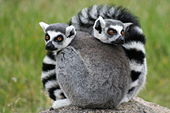 The ring-tailed lemur is one of around 100 known species and subspecies of lemur found only in Madagascar.[22]
The ring-tailed lemur is one of around 100 known species and subspecies of lemur found only in Madagascar.[22]
Lemurs have been characterized as "Madagascar's flagship mammal species" by Conservation International.[16] In the absence of monkeys and other competitors, these primates have adapted to a wide range of habitats and diversified into numerous species. As of 2008, there are officially 99 species and subspecies of lemur, 39 of which have been described by zoologists between 2000 and 2008.[23] They are almost all classified as rare, vulnerable, or endangered.[24] At least 17 species of lemur have become extinct since man arrived on Madagascar, all of which were larger than the surviving lemur species.[25]
The biodiversity of fauna in Madagascar extends beyond prosimians to the wider animal population. A number of other mammals, including the cat-like fossa, are endemic to Madagascar. Over 300 species of bird have been recorded on the island, of which over 60% (including four families and 42 genera) are endemic.[16] The few families and genera of reptile that have reached Madagascar have diversified into more than 260 species, with over 90% of these being endemic[26] (including one endemic family).[16] The island is home to two-thirds of the world's chameleon species,[26] and researchers have proposed that Madagascar may represent the origin of all chameleon species. Endemic fishes on Madagascar include two families, 14 genera and over 100 species primarily inhabiting the island's freshwater lakes and rivers. Although invertebrate species remain poorly studied on Madagascar relative to other wildlife, researchers have found high rates of endemism among known species. All 651 species of terrestrial snail are endemic, as are a majority of the island's butterflies, scarab beetles, lacewings, spiders and dragonflies.[16]
Environmental challenges
Madagascar's varied fauna and flora are endangered by human activity.[27] Since the arrival of humans 2,000 years ago, Madagascar has lost more than 90% of its original forest,[28] 70% was destroyed between 1895 and 1925, when Madagascar was under French rule.[29] One third has disappeared since the 1970s.[19] Key contributors to the loss of forest cover include the use of coffee as a cash crop[29], illegal logging and slash-and-burn activity, locally called tavy. This traditional practice was imported to Madagascar by the earliest settlers from Indonesia around 2,000 years ago and has strong cultural meaning in addition to its practical value as an agricultural technique.[30]
Habitat destruction and hunting have threatened many of Madagascar's endemic species or driven them to extinction. This process is exemplified by the extinction of elephant birds (Aepyornis), an endemic giant ratite that was formerly the world's largest bird. This species, whose average height was over 3 metres (10 ft) tall, has been extinct since at least the 17th century, most likely due to human hunting of adult birds and poaching of their massive eggs for food.[31] Numerous subfossil lemur species also vanished with the arrival of human settlers to the island, and today most extant lemurs are listed as endangered or threatened species due to habitat destruction. Many species have gone extinct over the course of the last centuries as a growing population has put greater pressures on lemur habitats and, among some populations, increased the rate of lemur hunting for food.[32]
Under President Marc Ravalomanana, a vigorous effort was made to expand Madagascar's protected natural areas. At the 2003 IUCN World Parks Congress in Durban, Ravalomanana announced the Durban Vision, a bold initiative to more than triple the area under protection from approximately 17,000 km² to over 60,000 km² (from 3% to 10% of Madagascar's area). As of 2011, areas protected by the state include five Strict Nature Reserves (Réserves Naturelles Intégrales), 21 Wildlife Reserves (Réserves Spéciales) and 21 National Parks (Parcs Nationaux).[33] In 2007 six of the national parks were voted in as a joint World Heritage Site under the name Rainforests of the Atsinanana. These six are: Marojejy, Masoala, Ranomafana, Zahamena, Andohahela and Andringitra National Park.[34] Local timber barons are harvesting scarce species of rosewood trees from protected rainforests such as Marojejy National Park and exporting the wood to China for the production of luxury furniture and musical instruments.[35] To raise public awareness of Madagascar's environmental challenges, the Wildlife Conservation Society opened an exhibit entitled "Madagascar!" in June 2008 at the Bronx Zoo in New York.[36]
History
Early history
Most archaeologists estimate that the earliest settlers arrived in outrigger canoes from southern Borneo between 200 BCE and 500 CE, making Madagascar one of the last major landmasses on Earth to be settled by people.[37] Upon arrival, early settlers practiced tavy (swidden, slash-and-burn agriculture) to clear the virgin coastal rainforests for the cultivation of their crops. The first settlers encountered Madagascar's wealth of megafauna, including giant lemurs, elephant birds, giant fossa and the Malagasy hippopotamus, which have since become extinct due to hunting and habitat destruction.[38] By 600 CE groups of these early settlers had moved inland and began clearing the forests of the central Highlands. Irrigated rice paddies emerged in highland Betsileo country by 1600 and were complemented with terraced paddies throughout Imerina a century later.[39] Zebu were introduced around 1000 CE by Bantu-speaking East African migrants who maintained large herds. The rising intensity of land cultivation and the ever-increasing demand for zebu pasturage in the central highlands had largely transformed the region from a forest ecosystem to barren grassland by the 17th century.[40] Merina oral histories tell of migration from the southeast coast to the central highlands where the Merina encountered an established population called the Vazimba, who may have been the descendants of an earlier and less technologically advanced Austronesian settlement wave.[41] The Vazimba were vanquished by Merina kings Andriamanelo, Ralambo and Andrianjaka in the 16th and early 17th centuries.[42]
Madagascar was an important transoceanic trading hub connecting ports of the Indian Ocean in the early centuries following human settlement. The written history of Madagascar begins in the 7th century when Arabs established trading posts along the northwest coast and introduced Islam, the Arabic script (used to transcribe the Malagasy language in a form of writing known as sorabe), Arab astrology and other cultural elements.[14] European contact began in 1500, when the Portuguese sea captain Diogo Dias sighted the island.[10] The French established trading posts along the east coast in the late 17th century. From about 1774 to 1824, it gained prominence among pirates and European traders, particularly those involved in the trans-Atlantic slave trade. The small island of Nosy Boroha off the northeastern coast of Madagascar has been proposed by some historians as the site of the legendary pirate utopia of Libertalia.[43] Many European sailors were shipwrecked on the coasts of the island, among them Robert Drury, whose journal is one of the few written depictions of life in southern Madagascar during the 18th century.[44] The wealth generated by maritime trade spurred the rise of organized kingdoms on the island, some of which had grown quite powerful by the 17th century.[45] Among these were the Betsimisaraka alliance of the eastern coast and the Sakalava chiefdoms of Menabe and Boina on the west coast. The Kingdom of Imerina, located in the central highlands with its capital at the royal palace of Antananarivo, likewise emerged at around the same time under the leadership of King Andriamanelo.[46]
Kingdom of Madagascar
Upon its emergence in the early 17th century, the highland kingdom of Imerina was initially a minor power relative to the larger coastal kingdoms[46] and grew even weaker in the early 18th century when King Andriamasinavalona divided it among his four sons. However, following a century of warring and famine, Imerina was reunited in 1793 by King Andrianampoinimerina (1787–1810).[47] From his capital at Ambohimanga (a UNESCO World Heritage Site), this Merina king rapidly expanded his rule over neighboring principalities with the intent to bring the entire island under his control,[48] an ambition largely achieved by his son and successor, King Radama I (1810–1828). Radama concluded a treaty with the British governor of Mauritius to abolish the lucrative slave trade in return for British military and financial assistance. Artisan missionary envoys from the London Missionary Society began arriving in 1818. James Cameron and others established schools, transcribed the Malagasy language using the Roman alphabet, translated the Bible, and introduced a variety of new technologies to the island.[49]
Radama's successor, Queen Ranavalona I (1828–1861), responded to increasing political and cultural encroachment on the part of Britain and France by issuing a royal edict prohibiting the practice of Christianity in Madagascar and eventually expelling all foreigners from the territory. She managed to preserve the island's sovereignty, but at a great cost, as many early Christians were vigorously persecuted and killed under her reign.[50] Her son and successor, Radama II (1861–1863), attempted to relax his mother's stringent policies but was overthrown two years later by Prime Minister Rainivoninahitriniony (1852–1865) and other courtiers.[13] The courtiers, seeking to end the absolute power of the monarch, offered Radama's queen Rasoherina (1863–1868) the opportunity to rule if she would accept a power sharing arrangement with the Prime Minister—a new social contract to be sealed by a political marriage between them.[51] Queen Rasoherina accepted, first wedding Rainivoninahitriniony, then later deposing him and wedding his brother, Prime Minister Rainilaiarivony (1864–1895), who would go on to marry Queen Ranavalona II (1868–1883) and Queen Ranavalona III) (1883–1897) in succession.[52]
French colonization
France invaded Madagascar in 1883 in what became known as the first Franco-Hova War on the pretext of the non-respect of the Lambert Charter—a document granting lucrative concessions to French citizens—and a letter entreating the assistance of the French in ending the rule of Ranavalona I, both signed by former king Radama II.[53] At the war's end, Madagascar ceded Antsiranana (Diego Suarez) on the northern coast to France and paid 560,000 francs to the heirs of Joseph-François Lambert.[54] In 1890, the British accepted the full formal imposition of a French protectorate. Ultimately, the French bombarded and occupied the harbor of Toamasina on the east coast, and Mahajanga on the west coast in December 1894 and January 1895 respectively.[55] The flying column proceeded to march toward Antananarivo but lost many to malaria and other diseases, necessitating reinforcements drawn from Algeria and Sub-Saharan Africa. Upon reaching the city in September 1895, the column bombarded the Rova palace with heavy artillery, causing heavy casualties and leading Queen Ranavalona III to surrender.[56]
After the conclusion of hostilities, in 1896 France annexed Madagascar. The 103-year-old Merina monarchy ended with the royal family being sent into exile, first to Reunion Island and then to Algeria the following year.[57] Slavery was abolished in 1896, but many of the 500,000 liberated slaves remained in their former master's homes as servants.[58]
Under colonial rule, plantations were established for the production of a variety of export crops.[59] Wide paved boulevards and gathering spaces were constructed in the capital city of Antananarivo[60] and the Rova palace compound was turned into a museum.[61] Schools were built, particularly in rural and coastal areas where the schools of the Merina had not reached; education became mandatory between the ages of 6 to 13 and focused primarily on French language and practical skills.[62] The Merina royal tradition of corvee—taxes paid in the form of labor—was continued under the French and used to construct a railway and roads linking the coastal cities to Antananarivo.[63] During World War I, 46,000 Malagasy troops[52] fought in France, Morocco, and Syria.[64] Some leaders in Nazi Germany proposed deporting all of Europe's Jews to Madagascar (the Madagascar Plan), but nothing came of this.[65] After France fell to Germany, the Vichy government administered Madagascar. During the Battle of Madagascar, British troops occupied the island in 1942 to preclude its seizure by the Japanese, after which the Free French took over.[66] With French prestige at low ebb after the end of World War II, the Malagasy Uprising of 1947 broke out. It was suppressed after over a year of bitter fighting, with death toll estimates ranging from 10,000 to over 80,000.[67] The French later established reformed institutions in 1956 under the Loi Cadre (Overseas Reform Act), and Madagascar moved peacefully towards independence. The Malagasy Republic was proclaimed on October 14, 1958, as an autonomous state within the French Community. A period of provisional government ended with the adoption of a constitution in 1959 and full independence on June 26, 1960.[68]
Government
Capital
Antananarivo is the capital and the largest city of Madagascar.[10] It is located in the highlands region, very near to the geographic center of the island. King Andrianjaka founded Antananarivo around 1610 or 1625 upon the site of a captured Vazimba capital on the hilltop of Analamanga.[42] In 1793 it became the capital, under the Merina kings, of the whole island, and in 1895, after the French conquest of Madagascar, the center of the French colonial administration. In 1960, after independence, it became the capital of the Malagasy Republic. In 2011, the capital's population was estimated at 903,000 inhabitants.
Administrative divisions
Madagascar was divided into six autonomous provinces (faritany mizakatena), and subdivided into 22 regions (faritra), the latter created in 2004. The regions became the highest subdivision level when the provinces were dissolved in accordance with the results of the 2007 referendum. The regions are further subdivided into 116 districts, 1,548 communes, and 16,969 fokontany. The major cities have a special status as "commune urbaine", at the same level as the districts.[citation needed]
Regions and former provinces New regions Former provinces Population Diana (1), Sava (2) Antsiranana 1,188,500 Itasy (3), Analamanga (4), Vakinankaratra (5), Bongolava (6) Antananarivo 4,637,000 Sofia (7), Boeny (8), Betsiboka (9), Melaky (10) Mahajanga 1,734,000 Alaotra Mangoro (11), Atsinanana (12), Analanjirofo (13) Toamasina 2,593,000 Amoron'i Mania (14), Haute-Matsiatra (15), Vatovavy-Fitovinany (16), Atsimo-Atsinanana (17), Ihorombe (18) Fianarantsoa 3,366,000 Menabe (19), Atsimo-Andrefana (20), Androy (21), Anosy (22) Toliara 2,229,550 Military
The rise of centralized kingdoms among the Sakalava, Merina and other ethnic groups produced the island's first standing armies by the 16th century, initially equipped with spears but later with muskets, cannons and other firearms.[69] By the early 19th century, Kingdom of Imerina was able to bring much of the island under Merina control with an army ranging from 20,000 to 30,000 soldiers.[70] French attacks on coastal towns in the later part of the century prompted British mercenaries to provide training to the queen's army. However, the Malagasy military proved unable to withstand French weaponry and was declared a colony of France in 1897.[71]
Madagascar regained political independence and sovereignty over its military in 1960.[72] Since this time the Malagasy military has never engaged in armed conflict with another state or within its own borders, but has occasionally intervened to restore order during periods of political unrest. Under the socialist Second Republic, Admiral Didier Ratsiraka declared mandatory national armed or civil service for all young citizens regardless of gender.[73] Ratsiraka would furthermore mobilize elements of the military to pacify unarmed protesters, occasionally using violent means. His order to fire upon unarmed protesters in 1989 was the catalyst for transition to the democratic Third Republic in 1992. The military remained largely neutral during the protracted standoff between incumbent Ratsiraka and challenger Marc Ravalomanana in the disputed 2001 presidential elections. By contrast, in 2009 a segment of the army defected to the side of Andry Rajoelina, then-mayor of Antananarivo, in support of his attempt to force President Ravalomanana from power. It is widely believed that payoffs were involved in persuading these military personnel to change camps in support of the coup d'etat.[74]
Politics
Although the head of state since March 2009 is self-proclaimed, Madagascar is usually a semi-presidential representative democratic multi-party republic, wherein the popularly elected President is the head of state and selects a Prime Minister to form a government. In the Malagasy system, the word government refers collectively to the President, the Prime Minister and all the heads of government ministries (Ministers), the latter being selected by the Prime Minister but serving at the pleasure of the President. According to the constitution, executive power is exercised by the government while legislative power is vested in both the government and the Senate and the National Assembly, although in reality these two latter bodies have very little power or legislative role. The constitution declares the judiciary to be independent of the executive and the legislature, but constitutional provisions empowering the Minister of Justice to interfere in operations of the judiciary branch effectively undermine intended separation of powers, consolidating the strength of the executive branch.[citation needed]
The political situation in Madagascar has been marked by struggle for control. After Madagascar gained independence from France in 1960, political transitions have been marked by numerous popular protests, several disputed elections, two military coups and one assassination. Didier Ratsiraka took power in a military coup in 1975 and ruled until 2001, with a short break when he was ousted in the early 1990s. When Marc Ravalomanana and Ratsiraka both claimed victory after presidential elections in December 2001, Ratsiraka's supporters tried to blockade the capital, Antananarivo, which was pro-Ravalomanana. After eight months of sporadic violence with considerable economic disruption, a recount in April 2002 led the High Constitutional Court to pronounce Ravalomanana president, but it was not until July that Ratsiraka fled to France and Ravalomanana gained control of the country.[75] Between 2002 and 2009, Ravalomanana and his party Tiako I Madagasikara (TIM) dominated political life. Ravalomanana's re-election in December 2006 was met with some protests over worsening standards of living, despite an ongoing government drive to eradicate poverty.[76]
A series of protests against then-President Marc Ravalomanana in 2009, backed by Andry Rajoelina, former mayor of Antananarivo, became violent, with more than 170 people killed.[77] Rajoelina mobilized his supporters to take to the streets of Antananarivo to demand Ravalomanana's ousting on the grounds of his autocratic style of government.[citation needed] After losing support of the military and under intense pressure from Rajoelina, President Ravalomanana resigned on March 17, 2009. Ravalomanana assigned his powers to a military council loyal to himself headed by Vice-Admiral Hyppolite Ramaroson.[78] The military called the move by Ravalomanana a "ploy"[78] and said that it would support Rajoelina as leader.[79] Rajoelina had already declared himself the new leader a month earlier and assumed the role of acting President, appointing Monja Roindefo as Prime Minister.[80] Rajoelina announced that elections would be held in two years and that the constitution would be amended.[79] The European Union, amongst other international entities, refused to recognize the new government, due to it being installed by force.[81] The African Union, which proceeded to suspend Madagascar's membership on March 20,[82] and the Southern Africa Development Community both criticized the forced resignation of Ravalomanana.[79]
Foreign relations
Madagascar was historically perceived as being on the margin of mainstream African affairs despite being a founding member of the Organisation of African Unity, which was founded in 1963. France remained the country's closest partner throughout the First Republic, stirring popular resentment and public protests that ultimately toppled the Tsiranana regime. Ratsiraka's socialist Second Republic turned its attention to partnerships with the Soviet Union, China and other socialist states. The weakened political and economic position of these partner states was a contributing factor to the collapse of the Second Republic.[citation needed]
The launch of the democratic Third Republic in 1993 marked a shift toward a capitalist economic growth model necessitating expanded diplomatic and economic ties within the global market. President Zafy, expressing desire for diplomatic relations with all countries, established formal ties with South Korea and sent emissaries to Morocco. The pressures of globalisation obliged President Ratsiraka to adhere to market-oriented policies and to engage world markets when he was voted into office in 1997. External relations have since reflected this trend, although Madagascar's physical isolation and strong traditional insular orientation have limited its activity in regional economic organizations and relations with its East African neighbours. It enjoys closer and generally good relations with its Indian Ocean neighbours – Mauritius, Réunion and Comoros. Active relationships with Europe, especially France, Germany, and Switzerland, as well as with Britain, Russia, Japan, India and China have been strong since independence. More recently, President Ravalomanana has cultivated strong links with the United States, and Madagascar was the first country to benefit from the Millennium Challenge Account. Madagascar is a member of the International Criminal Court with a Bilateral Immunity Agreement of protection for the United States military (as covered under Article 98). Numerous countries have established and maintain a diplomatic presence in Madagascar. During his presidency, Marc Ravalomanana traveled widely promoting Madagascar abroad and consciously sought to strengthen relations with Anglophone countries as a means of balancing traditionally strong French influence. He also cultivated strong ties with China during his tenure.[citation needed]
The Organisation of African Unity dissolved in 2002 and was replaced by the African Union. Madagascar was not permitted to attend the first African Union summit because of a dispute over the results of the election in December 2001, but rejoined the African Union in July 2003 after a 14-month hiatus triggered by the 2002 political crisis. However, Madagascar was suspended again by the African Union in March 2009 because of ongoing political crisis.[83]
In November 2004, after an absence of almost 30 years, Madagascar re-opened its embassy in London. On 15 December 2004 Foreign Secretary Jack Straw announced the closure of the British embassy in Antananarivo to save £250,000 per year. He also announced an end to the government's aid to Madagascar. The embassy closed in August 2005. The British Embassy was previously closed (also for financial reasons) from 1975 to 1980. The Anglo-Malagasy Society are campaigning to have it re-opened.[citation needed]
Human rights
Main article: Human rights in MadagascarHuman rights in Madagascar are protected under the constitution. However the extent to which such rights are reflected in practice, is subject to debate. The 2010 Human Rights Report by the United States Department of State noted concerns regarding the suspension of democratic electoral processes as the result of recent political unrest.[84] Furthermore, reports of corruption, arbitrary arrest, widespread underage prostitution and child labor highlight the prevalence of human rights issues in the country.[85] Accusations of media censorship have risen since 2009 due to the allegedly increasing restrictions on the coverage of government opposition.[84]
Economy
Madagascar's sources of growth are tourism, textile and light manufacturing exports (notably through the EPZs), agricultural products, and mining. Madagascar is the world's leading producer of vanilla and accounts for about half the world's export market. Tourism targets the niche eco-tourism market, capitalizing on Madagascar's unique biodiversity, unspoiled natural habitats, national parks and lemur species. Exports from the EPZs, located around Antananarivo and Antsirabe, comprise the majority of garment manufacture, targeting the US market under AGOA and the European markets under the Everything But Arms (EBA) agreement. Agricultural exports consist of low-volume high-value products like vanilla, lychees and essential oils. A small but growing part of the economy is based on mining of ilmenite, with investments emerging in recent years, particularly near Tulear and Fort Dauphin.[citation needed]
Natural resources
Madagascar's natural resources include a variety of unprocessed agricultural and mineral resources. Key agricultural resources include vanilla, lychees and shrimp. Key mineral resources include various types of precious and semi-precious stones, ilmenite and petrol. Several major projects are underway in the mining and oil and gas sectors that, if successful, will give a significant boost to the Malagasy economy. In the mining sector, these include the development of coal at Sakoa and nickel near Tamatave. In oil, Madagascar Oil is developing the massive onshore heavy oil field at Tsimiroro and ultra heavy oil field at Bemolanga. Mining corporation Rio Tinto Group began operations near Fort Dauphin in 2008, following several years of infrastructure preparation. The mining project is highly controversial, with Friends of the Earth and other environmental organizations filing reports to detail their concerns about effects on the local environment and communities.[86]
Infrastructure
International trade
Agriculture, including fishing and forestry, is a mainstay of the economy. Major exports are coffee, vanilla (Madagascar is the world's largest producer and exporter of vanilla), sugarcane, cloves, cocoa, rice, cassava (tapioca), beans, bananas, peanuts and livestock products. Vanilla has historically been of particular importance, and when in 1985 Coca-cola switched to New Coke which involved less vanilla, Madagascar's economy took a marked downturn but returned to previous levels after the return of Coke Classic.[87]
Domestic economy
Tourism
Economic development
Structural reforms began in the late 1980s, initially under pressure from international financial institutions, notably the World Bank. An initial privatization program (1988–1993) and the development of an export processing zone regime in the early 1990s were key milestones in this effort. A period of significant stagnation from 1991 to 1996 was followed by five years of solid economic growth and accelerating foreign investment. Although structural reforms advanced, governance remained weak, and perceived political corruption was high. During the period of solid growth from 1997 to 2001, poverty levels remained high, especially in rural areas.[citation needed]
A six-month political crisis triggered by a dispute over the outcome of the presidential elections held in December 2001 virtually halted economic activity in much of the country in the first half of 2002. Real GDP dropped 12.7% for the year 2002, inflows of foreign investment dropped sharply, and the crisis tarnished Madagascar's budding reputation as an AGOA standout and a promising place to invest. After the crisis, the economy rebounded with GDP growth of over 10% in 2003. Currency depreciation and rising inflation in 2004 have hampered economic performance, but growth for the year reached 5.3%, with inflation reaching around 25% at the end of the year. In 2005 inflation was brought under control by tight monetary policy of raising the Taux Directeur (central bank rate) to 16% and tightening reserve requirements for banks. Thus growth was expected to reach around 6.5% in 2005.[citation needed]
Following the 2002 political crisis, the government attempted to set a new course and build confidence, in coordination with international financial institutions and donors. Madagascar developed a recovery plan in collaboration with the private sector and donors and presented it at a "Friends of Madagascar" conference organized by the World Bank in Paris in July 2002. Donor countries demonstrated their confidence in the new government by pledging $1 billion in assistance over five years. The Malagasy Government identified road infrastructure as its principle priority and underlined its commitment to public-private partnership by establishing a joint public-private sector steering committee.[citation needed]
In 2000, Madagascar embarked on the preparation of a Poverty Reduction Strategy Paper (PRSP) under the Heavily Indebted Poor Countries (HIPC) Initiative. The boards of the IMF and World Bank agreed in December 2000 that the country had reached the decision point for debt relief under the HIPC Initiative and defined a set of conditions for Madagascar to reach the completion point. In October 2004, the boards of the IMF and the World Bank determined that Madagascar had reached the completion point under the enhanced HIPC Initiative.[88]
The Madagascar-U.S. Business Council was formed as a collaboration between the United States Agency for International Development (USAID) and Malagasy artisan producers in Madagascar in 2002. The U.S.-Madagascar Business Council was formed in the United States in May 2003, and the two organizations continue to explore ways to work for the benefit of both groups.[89]
The government of President Ravalomanana aggressively sought foreign investment and attempted to tackle many of the obstacles to such investment, including combating corruption, reforming land-ownership laws, encouraging study of American and European business techniques, and active pursuit of foreign investors. President Ravalomanana rose to prominence through his agro-foods TIKO company, and attempted to apply many of the lessons learned in the world of business to running the government. In the latter half of his presidency, concerns arose about the conflict of interest between his policies and the activities of his firms. Most notable among them the preferential treatment for rice imports initiated by the government in late 2004 when responding to a production shortfall in the country.[citation needed]
Demographics
Madagascar's population is predominantly of mixed Austronesian (i.e. South-East Asian/Pacific Islander) and African origin.[90] Those who are visibly Austronesian in appearance and culture are the minority, found mostly in the highland regions. Recent DNA research shows that the Malagasy people are approximately of half Austronesian and half East African descent, although some Arab, Indian and European influence is present along the coast.[91]
Subsequent migrations from the East Indies and Africa consolidated this original mixture, and over a dozen distinct tribal groups emerged. Austronesian features are most predominant in the Merina (3 million); the coastal people (called côtiers) have relatively stronger African origins. The largest coastal groups are the Betsimisaraka (1.5 million) and the Tsimihety and Sakalava (700,000 each). The Vezo live in the southwest. Two of the southern tribes are the Antandroy and the Antanosy. Other tribes include Tankarana (northern tip), Sihanaka and Bezanozano (east), Tanala (south-east), Antaimoro, Tambahoaka, Zafisoro, Antaisaka and Timanambondro (south-east coast), and Mahafaly and Bara (south-west). Chinese and Indian minorities also exist, as well as Europeans, mostly French. In 1958, there were 68,430 European settlers living in Madagascar.[92] The number of Comorans residing in Madagascar was drastically reduced after anti-Comoran rioting in Mahajanga in 1976.[14]
During the French colonial administration (1895–1960) and some time after independence, people were officially classified in ethnic groups. This practice was abandoned in the first census (1975) after independence[93] so any recent classification and figures for ethnic groups is an unofficial estimate. There is for instance no mention of ethnicity or religion in the national identity cards. Also, territorial divisions (provinces, regions) do not follow any ethnic division lines, despite an attempt by the colonial administration in the early 20th century. Ethnic divisions continue, and may cause violence, but their role is limited in today's society. Political tensions between the highlanders and coastal population periodically flare up into limited violent conflict.[94]
The population has grown from 2.2 million in 1900 to 7.6 million in 1975.[95] Only two general censuses, 1975 and 1993, have been carried out after independence. Figures for Madagascar's foreign population in the early 1990s are lacking, but in 1988, such persons were estimated to include 25,000 Comorans, 18,000 French, 17,000 Indians, and 9,000 Chinese.[95]
Health
Maternal and Child Health Care
In June 2011, the United Nations Population Fund released a report on The State of the World's Midwifery. It contained new data on the midwifery workforce and policies relating to newborn and maternal mortality for 58 countries. The 2010 maternal mortality rate per 100,000 births for Madagascar is 440. This is compared with 373.1 in 2008 and 484.4 in 1990. The under 5 mortality rate, per 1,000 births is 61 and the neonatal mortality as a percentage of under 5's mortality is 37. The aim of this report is to highlight ways in which the Millennium Development Goals can be achieved, particularly Goal 4 – Reduce child mortality and Goal 5 – improve maternal death. In Madagascar the number of midwives per 1,000 live births is 4 and 1 in 45 shows us the lifetime risk of death for pregnant women. [96] Two-thirds of the population live below the international poverty line of US$1.25 per day.[97]
Education
Prior to the 19th century, all learning in Madagascar was informal and typically served to teach practical skills as well as social and cultural norms, including respect for ancestors and elders.[14] The first formal European-style school was established in 1818 on the east coast of Madagascar at Toamasina by members of the London Missionary Society (LMS). King Radama I (1810–1828) invited LMS missionaries to establish schools throughout Imerina to teach basic literacy and numeracy to the children of andriana (nobles) who would go on to serve as soldiers or royal aides. Because the missionaries insisted on using the Bible to teach literacy in support of their own agenda to spread Christianity, Radama's successor, Ranavalona I, expelled the missionaries and closed the schools in 1835.[98] This policy was reversed upon her death, and by the end of the 19th century Madagascar could boast the most developed and modern school system in pre-colonial Sub-Saharan Africa.[99]
Limited access and poor quality have plagued the schools of Madagascar from the colonial period to the present. During the post-colonial First Republic, a continued reliance on French nationals as teachers and French as the language of instruction created tension among those desiring a complete separation from the former colonial power. Consequently, under the socialist Second Republic, French instructors and other nationals were expelled, Malagasy was declared the language of instruction and a large cadre of young Malagasy were rapidly trained to teach at remote rural schools under the mandatory two-year national service policy.[100] This policy, known as malgachization, coincided with a severe economic downturn and a dramatic decline in the quality of education; people schooled during this period generally failed to master the French language or many other subjects. Struggling in the competitive local employment market, most remained mired in deepening poverty as they were obliged to turn to low-paying jobs in the informal or black market. Excepting the brief presidency of Albert Zafy from 1992 to 1996, Ratsiraka remained in power from 1975 to 1999 and failed to achieve significant improvements in the sector throughout this time.[101]
Education was prioritized under the Ravalomanana administration. During his first term, thousands of new schools and additional classrooms were constructed while many older buildings were renovated. Tens of thousands of new teachers were recruited and trained. The minimum education standard for the recruitment of primary teachers was raised from a middle school leaving certificate (BEPC) to a high school leaving certificate (BAC). School supplies and uniforms were provided at public schools and official school fees were eliminated, although fees are still commonly charged by parent-teacher associations to pay the salaries of teachers hired locally when demand for education exceeds official capacity. Public expenditure on education was at 16.4% of total government expenditure in the 2000–2007 period with per-pupil expenditure at the primary level at about US$57.[citation needed] As a result, primary school enrollment rates jumped from 63% in 2000 to 95% in 2005. Increased access has posed continuing challenges for quality, however, and Madagascar continues to have extremely high rates of grade repetition and student drop-out. Education policy in Ravalomanana's second term focused on quality issues, including a reformed teacher training program to support the transition from traditional didactic instruction to student-centered teaching methods to boost student learning and participation in the classroom.[102]
Society
Ethnic diversity
Main article: Ethnic groups of MadagascarThe majority of the population of Madagascar is a mixture in varying degrees of Indonesian, Arab and Bantu settlers from Southeast Asia, the Arabian Peninsula and East Africa, respectively.[103] Years of intermarriages created the Malagasy people, who primarily speak Malagasy, an Austronesian language with Bantu influences. Most of the genetic makeup of the average Malagasy, however, reflects an almost equal blend of Indonesian and Bantu influences.[104]
Malagasy Ethnic Groups Peoples Regional concentration Antankarana, Sakalava, Tsimihety Antsiranana Province Sakalava, Vezo Mahajanga Province Betsimisaraka, Sihanaka, Bezanozano Toamasina Province Merina Antananarivo Province Betsileo, Antaifasy, Antambahoaka, Antaimoro, Antaisaka, Tanala Fianarantsoa Province Mahafaly, Antandroy, Antanosy people, Bara, Vezo Toliara Province Language
The Malagasy language is of Malayo-Polynesian origin and is generally spoken throughout the island. The numerous dialects of Malagasy, which are generally mutually intelligible, can be clustered under one of two sub-groups: eastern Malagasy (spoken along the eastern forests and highlands, including the Merina dialect of Antananarivo) and western Malagasy, spoken across the western coastal plains. French became the official language during the colonial period when Madagascar came under the authority of France. In the first national Constitution of 1958, Malagasy and French were named the official languages of the Malagasy Republic. Madagascar is a francophone country, and French is spoken among the educated population. English, although uncommon, has gradually become more widely spoken.[105]
No official languages were recorded in the Constitution of 1992, although Malagasy was identified as the national language. Nonetheless, many sources still claimed that Malagasy and French were official languages, eventually leading a citizen to initiate a legal case against the state in April 2000 on the grounds that the publication of official documents in the French language only was unconstitutional. The High Constitutional Court observed in its decision that, in the absence of a language law, French still had the character of an official language.[106] In the Constitution of 2007, Malagasy remained the national language while official languages were reintroduced: Malagasy, French, and English.[107] English was removed as an official language from the constitution approved by voters in the November referendum 2010.[citation needed] The outcome of the referendum and its consequences for official and national language policy are not recognized by the political opposition or by the international community, who cite lack of transparency and inclusiveness in the organization of the election by the High Transitional Authority.[108]
Religion
Main articles: Religion in Madagascar, Malagasy mythology, Roman Catholicism in Madagascar, Church of Jesus Christ in Madagascar, Islam in Madagascar, and Hinduism in MadagascarApproximately 50% of the country's population practice traditional religion, which tends to emphasize links between the living and the dead. The Merina in the highlands particularly tend to hold tightly to this practice. A powerful individual may establish a fady (taboo) in his or her lifetime that all their descendents or those of community members will be required to respect well after their death, meaning that when traveling in Madagascar it is advisable to seek out village elders or authorities and inquire into local fady in order not to inadvertently transgress and offend the local population. This veneration of ancestors has also led to the tradition of tomb building and the famadihana, a practice whereby a deceased family member's remains may be taken from the tomb to be periodically re-wrapped in fresh silk shrouds known as lamba before being replaced in the tomb. The event is an occasion to celebrate the loved one's memory, reunite with family and community, and enjoy a festive atmosphere. Residents of surrounding villages are often invited to attend the party, where food and rum are often served and a hiragasy troupe or other musical entertainment is typically present.[citation needed]
About 45% of the Malagasy are Christian, divided almost evenly between Catholics and Protestants. In 1818 the London Missionary Society sent the first Christian missionaries to successfully install themselves on the island, building churches, translating the Bible into Malagasy language and winning over numerous converts. Beginning in 1835 Queen Ranavalona I vigorously persecuted early converts to Christianity in an attempt to halt European cultural and political influence on the island. In 1869 a successor, Queen Ranavalona II, converted the court to Christianity and encouraged Christian missionary activity, burning the sampy (royal idols) in a symbolic break with traditional beliefs.[109] Today, many Christians integrate their religious beliefs with traditional ones relating to honoring the ancestors. For instance, they may bless their dead at church before proceeding with traditional burial rites or invite a Christian minister to consecrate a famadihana reburial. Many of the Christian churches are influential in politics. The best example of this is the Malagasy Council of Churches comprising the four oldest and most prominent Christian denominations (Roman Catholic, Church of Jesus Christ in Madagascar, Lutheran, and Anglican).[citation needed]
Eastern religions are also present on the island. Islam was first brought to the island in the Middle Ages by Arab and Somali Muslim traders who established several Islamic schools along the eastern coast. While the use of Arabic script and loan words and the adoption of Islamic astrology would spread across the island, the Islamic religion failed to take hold in all but a handful of southeastern coastal communities. Today, Muslims constitute 7% of the population of Madagascar and are largely concentrated in the northwestern provinces of Mahajanga and Antsiranana (Diego Suarez). Muslims are divided between those of Malagasy ethnicity, Indians, Pakistanis and Comorians. More recently, Hinduism was introduced to Madagascar through Gujarati people immigrating from the Saurashtra region of India in the late 19th century. Most Hindus in Madagascar speak Gujarati or Hindi.[citation needed]
Culture
Main articles: Architecture of Madagascar, Malagasy cuisine, Music of Madagascar, Hainteny, Lamba (garment), and HiragasyMalagasy culture reflects a blend of Southeast Asian, Arab, African and European influences.
Houses in Madagascar are typically four-sided with a peaked roof similar to those commonly seen in Southeast Asia, rather than the circular style of hut more commonly found in Eastern Africa. Malagasy architecture varies widely depending on locally available materials and practical needs. Most traditionally, homes are built from plant materials; this form of construction remains prevalent outside of the central Highlands and major urban areas. In the Highlands, houses are most often two-story brick structures, occasionally with pillars supporting a front veranda. The orientation and interior layout of homes in traditional communities often followed certain cosmological norms. This tradition has been increasingly abandoned over the past century, as has the use of traditional building materials among the upper classes for whom imported materials and foreign construction styles are associated with modernity and prestige.[110] Tombs are culturally significant in many regions and tend to utilize stone in their construction.[111]
The zebu (humped cattle), introduced to Madagascar by Bantu-speaking East African migrants around 1,000 years ago, have come to occupy an important place in traditional Malagasy culture. The animal can take on sacred importance and constitutes the wealth of the owner, a tradition originating on the African mainland.[112] Cattle rustling, originally a rite of passage for young men in the plains areas of Madagascar where the largest herds of cattle are kept, has become a dangerous and sometimes deadly criminal enterprise as herdsmen in the southwest attempt to defend their cattle with traditional spears against increasingly armed professional rustlers. Where African influences are strongest, as in the southern region around Tulear, wealth and social status are traditionally measured in cattle.[112]
The Malagasy names for seasons, months, days, and coins are Arabic in origin, as is the practice of circumcision, the communal grain pool, and different forms of salutation. The Antaimoro people of southeastern Madagascar claim to be direct descendants of early Arab immigrants, and over at least the past five hundred years, the acclaimed ombiasy (astrologers) of this ethnic group have served as privileged counselors to the nobles of various communities across the island.[citation needed]
The cuisine of Madagascar likewise reflects diverse influences from around the world. Rice forms the basis of every meal in most parts of Madagascar,[113] which has the highest per capita rate of rice consumption in the world.[114] The dishes prepared to accompany the rice vary depending on local availability of food products and are known as laoka. Many of these dishes reflect the culinary influences of Indian, Chinese, French and other arrivals to the island. A wide variety of snacks and street foods are eaten, particularly mofo (fritter or cake-like treats).[115] In the arid south and west, rice may be supplanted by cassava (yuca), sweet potatoes and corn and supplemented with curdled or fresh zebu milk.[116] Rum (toaka gasy) and betsabetsa are two forms of traditional spirits produced on the island. Wine and beer are also locally produced, as are cocoa, tea and coffee, the latter widely consumed throughout the island. Herbal teas, sodas and fruit juices are also popular drinks.[74]
Arts
Artistic traditions on the island of Madagascar are highly diverse and distinctive.
One of the island's foremost artistic traditions is that of its oratory as expressed in the forms of hainteny (poetry), kabary (public discourse) and ohabolana (proverbs).[citation needed] An epic poem showcasing these traditions, the Ibonia, has been handed down over the centuries in several different forms across the island and offers insight into the diverse mythologies and beliefs of traditional Malagasy communities.[117] Storytelling and proverbs enabled traditional communities to express and preserve their histories and worldview and transmit it to future generations. The supernatural is featured in many of these stories, including witchcraft, the intercession of god or the ancestors, and the existence of a variety of fantastical creatures. Chief among these are the vazimba, the supposed first inhabitants of Madagascar who have in popular memory been transformed into capricious spirits that, if angered, will interfere in the lives of the living.[118]
Madagascar has also developed a distinctive and rich musical heritage. The early Austronesian settlers brought with them the predecessor to the bamboo tube zither known as the valiha—considered the national instrument of Madagascar—as well as numerous other instruments that constitute the foundation of traditional Malagasy music.[119] The influence of African musical tradition manifests in certain drumming and polyharmonic singing styles, particularly among the western and southern coastal communities, while the tendency toward minor chords in these regions reflects an Arab musical influence.[120] Europeans likewise contributed to Malagasy musical traditions, importing the guitar, accordion, piano and the instruments used in hiragasy performance including the violin, trumpet and clarinet.[121]
Sport and recreation
A number of traditional pastimes have emerged in Madagascar. Moraingy or lutte malgache, a type of hand-to-hand combat, is a popular spectator sport in coastal regions. It is traditionally practiced by men, but women have recently begun to participate. The wrestling of zebu is also practiced in many regions. In addition to sports, a wide variety of games are played. Fanorona is a board game that is associated with the Merina sovereigns and is widespread throughout the Highland regions. According to folk legend, the succession of King Andrianjaka after his father Ralambo was partially due to the unhealthy obsession that Andrianjaka's older brother may have had with playing fanorona to the detriment of his other responsibilities.[citation needed]
Western sports were introduced to Madagascar over the past two centuries. Football and rugby are especially popular. Pétanque, a French game similar to lawn bowling, is also widely played in urban areas and particularly throughout the Highlands. Madagascar has produced a world champion in pétanque.[citation needed]
Scouting is popular among boys and girls alike and is represented in Madagascar by its own local association.[citation needed]
See also
- Outline of Madagascar
- Index of Madagascar-related articles
Notes
- ^ Le Comité Consultatif Constitutionnel (October 1, 2010). "Projet de Constitution de la Quatrième République de Madagascar". Madagascar Tribune. Archived from the original on August 24, 2011. http://www.webcitation.org/61BvMnZmH. Retrieved August 24, 2011. (French)
- ^ "Malagasy" is the correct form in English; Embassy of Madagascar, Washington D.C. "Madagascan" is used only for the island, not its people National Geographic Style Manual
- ^ Razafison, Rivonala (29 October 2011). "Madagascar: Rajoelina appoints a 'consensus' prime minister". Africa Review (National Media Group, Kenya). http://www.africareview.com/News/Madagascar+gets+new+premier/-/979180/1263702/-/12d32af/-/. Retrieved 2011-10-29.
- ^ a b c Central Intelligence Agency (2011). "Madagascar". The World Factbook. Archived from the original on August 24, 2011. http://www.webcitation.org/61BpMkYSR. Retrieved August 24, 2011.
- ^ The World Bank Group (December 2010). "Madagascar: Data Profile". World Development Indicators Database. The World Bank. Archived from the original on August 24, 2011. http://www.webcitation.org/61BwUGbye. Retrieved August 24, 2011.
- ^ a b Bradt (2011), p. 2
- ^ Government of Madagascar. "Website of the Embassy of Madagascar, Washington D.C.". Archived from the original on March 20, 2011. http://www.webcitation.org/5xJKICHn7. Retrieved April 30, 2006.
- ^ Cousins (1895), pp. 11–12
- ^ Room (2006), p. 230
- ^ a b c d Bureau of African Affairs (May 3, 2011). "Background Note: Madagascar". U.S. Department of State. Archived from the original on August 24, 2011. http://www.webcitation.org/61Be3ZCkK. Retrieved August 24, 2011.
- ^ Moriarty, H.A. (1891). Islands in the southern Indian Ocean, westward of longitude 80 ̊east, including Madagascar. London: J. D. Potter. pp. 1–2. http://books.google.com/books?id=-NmhAAAAMAAJ&printsec=frontcover#v=onepage&q&f=false.
- ^ University of Berkeley: Understanding Evolution (October 2009). "Where did all of Madagascar's species come from?". Archived from the original on March 19, 2011. http://www.webcitation.org/5xIlRolGu. Retrieved March 19, 2011.
- ^ a b c Encyclopaedia Britannica (2011). "Madagascar: Land—Relief". Encyclopaedia Britannica. Eb.com. Archived from the original on August 25, 2011. http://www.webcitation.org/61F14kYLY. Retrieved August 25, 2011.
- ^ a b c d Metz, Helen Chapin (1994). "Library of Congress Country Studies: Madagascar". Archived from the original on February 1, 2011. http://www.webcitation.org/5wBtCIo0q. Retrieved February 1, 2011.
- ^ a b Bradt (2011), pp. 35–46
- ^ a b c d e f g Conservation International (2007). "Madagascar and the Indian Ocean Islands". Biodiversity Hotspots. Conservation International. Archived from the original on August 24, 2011. http://www.webcitation.org/61BgLGwzk. Retrieved August 24, 2011.
- ^ Hobbes & Dolan (2008), p. 517
- ^ Hillstrom, Kevin; Collier Hillstrom, Laurie (2003). Africa and the Middle East: a continental overview of environmental issues. Santa Barbara, CA: ABC-CLIO. p. 50. ISBN 9781576076880. http://books.google.com/books?id=XxIk9zTm_e8C&printsec=frontcover#v=onepage&q&f=false.
- ^ a b "Science News: New Genus of Self-destructive Palm found in Madagascar". Kew Royal Botanic Gardens. Archived from the original on March 20, 2011. http://www.webcitation.org/5xJN1ydmX. Retrieved January 30, 2008.
- ^ McLendon, Chuck (May 16, 2000). "Ravenala madagascariensis". Floridata.com. Archived from the original on March 20, 2011. http://www.webcitation.org/5xJNG5WcZ. Retrieved September 14, 2009.
- ^ Lambahoany Ecotourism Centre (August 24, 2011). "Nature of Madagascar". Lambahoany Ecotourism Centre. Archived from the original on August 24, 2011. http://www.webcitation.org/61Bemker1. Retrieved August 24, 2011.
- ^ Long Yongcheng, R.A.; Wallis, J.; Rylands, A.B. et al., eds (2009) (PDF). Primates in Peril: The World's 25 Most Endangered Primates 2008–2010. Illustrated by S.D. Nash. IUCN/SSC Primate Specialist Group, International Primatological Society, and Conservation International. pp. 1–92. ISBN 9781934151341. http://www.primate-sg.org/PDF/Primates.in.Peril.2008-2010.pdf.
- ^ Mittermeier, R., Ganzhorn, J., Konstant, W., Glander, K., Tattersall, I., Groves, C., Rylands, A., Hapke, A., Ratsimbazafy, J., Mayor, M., Louis, E., Rumpler, Y., Schwitzer, C. & Rasoloarison, R. (December 2008). "Lemur diversity in Madagascar". International Journal of Primatology 29 (6): 1607–1656. doi:10.1007/s10764-008-9317-y.
- ^ Thornback & Harcourt (1990), p.
- ^ Jungers WL, Godfrey LR, Simons EL, Chatrath PS (October 1997). "Phalangeal curvature and positional behavior in extinct sloth lemurs (Primates, Palaeopropithecidae)". Procedures of the National Academy of Science (U.S.A.) 94 (22): 11998–2001. Bibcode 1997PNAS...9411998J. doi:10.1073/pnas.94.22.11998. PMC 23681. PMID 11038588. Archived from the original on March 20, 2011. http://www.webcitation.org/5xJO53Gq0.
- ^ a b Okajima, Yasuhisa; Kumazawa, Yoshinori (July 15, 2009). "Mitogenomic perspectives into iguanid phylogeny and biogeography: Gondwanan vicariance for the origin of Madagascan oplurines". Gene (Elsevier) 441 (1–2): 28–35. doi:10.1016/j.gene.2008.06.011. PMID 18598742.
- ^ "Everglades, Madagascar Rain Forest on UNESCO List". ABC News. July 30, 2010. Archived from the original on March 20, 2011. http://www.webcitation.org/5xJOOgK9M. Retrieved February 11, 2011.
- ^ National Geographic (2001). "Madagascar subhumid forests". Archived from the original on March 20, 2011. http://www.webcitation.org/5xJOoAxSC. Retrieved April 30, 2006.
- ^ a b Emoff, Ron (2004). "Spitting into the wind: Multi-edged environmentalism in Malagasy song". Island musics (Berg): 217. http://books.google.com/books?id=owU3-pCIvyYC&pg=PA51&lpg=PA51&dq=spitting+wind+madagascar&source=bl&ots=XEGYeXrLeR&sig=9Pp9AltA6EY3-YAzJ0_G5fQTQwo&hl=fr&ei=PITBTsuzDI3OswbX_Lm0Aw&sa=X&oi=book_result&ct=result&resnum=1&ved=0CBsQ6AEwAA#v=onepage&q=spitting%20wind%20madagascar&f=false. Retrieved 2011-11-05.
- ^ Bradt (2011), p. 41
- ^ Davies (2003), pp. 99–101
- ^ Handwerk, Brian (August 21, 2009). "Lemurs Hunted, Eaten Amid Civil Unrest, Group Says". National Geographic News. Archived from the original on March 20, 2011. http://www.webcitation.org/5xJPPb7Ap. Retrieved March 15, 2011.
- ^ Madagascar National Parks (2011). "The Conservation". www.parcs-madagascar.com/. Archived from the original on August 25, 2011. http://www.webcitation.org/61F71nCWI. Retrieved August 25, 2011.
- ^ "Rainforests of the Atsinanana". UNESCO. Archived from the original on August 25, 2011. http://www.webcitation.org/61F7YBBDB. Retrieved April 30, 2011.
- ^ Bearak, Barry (May 24, 2010). "Shaky Rule in Madagascar Threatens Trees". New York Times (New York). Archived from the original on March 20, 2011. http://www.webcitation.org/5xJPiZaaW. Retrieved March 20, 2011.
- ^ Luna, Kenny. "Madagascar! to Open at Bronx Zoo in Green, Refurbished Lion House". Treehugger. Archived from the original on July 10, 2011. http://www.webcitation.org/604iG5iy7. Retrieved June 11, 2011.
- ^ Diamond (1999), p. 50
- ^ Virah-Sawmy, M.; Willis, K.J.; Gillson, L. (2010). "Evidence for drought and forest declines during the recent megafaunal extinctions in Madagascar". Journal of Biogeography 37 (3): 506–519. doi:10.1111/j.1365-2699.2009.02203.x.
- ^ Campbell (1993), p. 116
- ^ Gade, Daniel (1996). "Deforestation and its effects in Highland Madagascar". Mountain Research and Development 16 (2): 101–116. doi:10.2307/3674005.
- ^ Razafimahazo, S. (2011). "Vazimba: Mythe ou Realité?". Revue de l’Océan Indien. Madatana.com. Archived from the original on July 10, 2011. http://www.webcitation.org/604cdM4qI. Retrieved November 8, 2010.
- ^ a b Domenichini, J.P.. "Antehiroka et Royauté Vazimba". Express de Madagascar. Madatana.com. Archived from the original on July 10, 2011. http://www.webcitation.org/604VDG1dG. Retrieved November 5, 2010.
- ^ Oliver (1886), p. 16
- ^ From MADAGASCAR to the MALAGASY REPUBLIC, by Raymond K. Kent pg 65–71
- ^ "Kingdoms of Madagascar: Maroserana and Merina". Metmuseum.org. Archived from the original on July 10, 2011. http://www.webcitation.org/604iN3JCP. Retrieved April 25, 2010.
- ^ a b Ogot (1992), p. 418
- ^ Hodder (1982), p. 59
- ^ "Royal Hill of Ambohimanga". UNESCO. Archived from the original on July 10, 2011. http://www.webcitation.org/604iRR1dZ. Retrieved April 30, 2011.
- ^ Ade Ajayi (1998), pp. 392–396
- ^ Halpern, Peter (2003). The healing trail: essential oils of Madagascar. Basic Health Publications, Inc.. p. 25. ISBN 1591200164.
- ^ Oliver (1886), pp. 124–126
- ^ a b Bradt (2011), p. 7
- ^ Van Den Boogaerde (2008), p. 7
- ^ Randier (2006), p. 400
- ^ Curtin, Philip D. (1998). Disease and empire: the health of European troops in the conquest of Africa. Cambridge, MA: Cambridge University Press. p. 186. ISBN 9780521598354.
- ^ Oliver (1985), p. 529
- ^ Oliver (1985), p. 532
- ^ Shillington, Kevin (2005). Encyclopedia of African history. New York, NY: CRC Press. p. 878. ISBN 1579584535.
- ^ Campbell (2005), p. 107
- ^ Fournet-Guérin (2007), pp. 45–54
- ^ Frémigacci (1999), pp. 421–444
- ^ Gallieni (1908), pp. 341–343
- ^ Reinsch (1905), p. 377
- ^ Ellicott (2004), p. 1087
- ^ Browning (2004), pp. 81–89
- ^ Bradt (2011), p. 325
- ^ Lehoullier (2010), p. 107
- ^ Pryor (1990), pp. 209–210
- ^ Barendse (2002), pp. 259–274
- ^ Freeman (1840), p.
- ^ Bradt (2011), pp. 7–10
- ^ "The Military Balance 2010". International Institute of Strategic Studies. pp. 314–315, 467. Archived from the original on April 1, 2011. http://www.webcitation.org/5xceWrXPC. Retrieved April 1, 2011.
- ^ Strakes (2006), p. 86
- ^ a b Bradt (2011), pp.
- ^ "MADAGASCAR: Former president sentenced to five years in prison". Irinnews.org. December 17, 2003. Archived from the original on July 10, 2011. http://www.webcitation.org/604iepG98. Retrieved April 25, 2010.
- ^ "Madagascar: Hoping for fair, transparent, uncontroversial elections". Irinnews.org. November 15, 2006. Archived from the original on July 10, 2011. http://www.webcitation.org/604ioc7sa. Retrieved April 25, 2010.
- ^ "Madagascar: Appeal launched despite political uncertainty". Irinnews.org. April 7, 2009. Archived from the original on July 10, 2011. http://www.webcitation.org/604j587uf. Retrieved April 25, 2010.
- ^ a b Corbett, Christina; McGreal, Chris (March 18, 2009). "Madagascar's president resigns as rival claims power". The Guardian. Archived from the original on July 10, 2011. http://www.webcitation.org/604kZq1zZ.
- ^ a b c "Military backs Madagascar rival". BBC News. March 17, 2009. Archived from the original on July 10, 2011. http://www.webcitation.org/604klovGA. Retrieved June 10, 2011.
- ^ "Madagascan opposition takes over prime minister's office". Xinhua. March 14, 2009. Archived from the original on July 10, 2011. http://www.webcitation.org/604kqSWHE. Retrieved May 5, 2010.
- ^ "Madagascar President Resigns". Voice of America. Archived from the original on July 10, 2011. http://www.webcitation.org/604l0IlJc. Retrieved March 17, 2009.
- ^ "African Union suspends Madagascar over 'coup'—Africa, World". The Independent. March 20, 2009. Archived from the original on July 10, 2011. http://www.webcitation.org/604l5oH0e. Retrieved April 25, 2010.
- ^ "Pressure grows on Madagascar coup". BBC News. March 20, 2009. Archived from the original on July 10, 2011. http://www.webcitation.org/604XDz2yB. Retrieved March 30, 2009.
- ^ a b Bureau of Democracy, Human Rights, and Labor (April 8, 2011). "2010 Human Rights Report: Madagascar". U.S. Department of State. Archived from the original on July 10, 2011. http://www.webcitation.org/604YfHcMq. Retrieved July 10, 2011.
- ^ Lawson & Bertucci (1996), pp. 978–979
- ^ "Rio Tinto's Madagascar mining project". Foe.co.uk. October 24, 2007. Archived from the original on July 10, 2011. http://www.webcitation.org/604ll0cfd. Retrieved April 25, 2010.
- ^ "Madagascar: Country Facts". Goway.com. Archived from the original on July 10, 2011. http://www.webcitation.org/604lsMYed. Retrieved April 25, 2010.
- ^ "Madagascar". International Monetary Fund. Archived from the original on July 10, 2011. http://www.webcitation.org/604i5gTJU. Retrieved April 30, 2011.
- ^ Ashamu, Charlotte; Gomez-Pickering, Diego; Luke, Amanda; Morrison, Paul; Pedersen, Mark; Symes, Mara; Weyandt, Marthe (2005). "Made in Madagascar: Exporting Handicrafts to the U.S. Market: Final Report". United Nations Public-Private Alliance for Rural Development. Archived from the original on July 10, 2011. http://www.webcitation.org/604ZDmy4U. Retrieved July 10, 2011.
- ^ Tofanelli S. et al. (2009). "On the origins and admixture of Malagasy: new evidence from high-resolution analyses of paternal and maternal lineages". Molecular Biology and Evolution 26 (9): 2109–2124. doi:10.1093/molbev/msp120. PMID 19535740.
- ^ Adelaar (2006), pp. 205–235
- ^ "The educated African: a country-by-country survey of educational development in Africa". Helen A. Kitchen (1962). p.256.
- ^ Haisoratra. "L'ethnicisation des rapports sociaux à Madagascar". Haisoratra.org. http://www.haisoratra.org/breve.php3?id_breve=225. Retrieved 2010-04-25.
- ^ "Ethnic strife rocks Madagascar". BBC News. May 14, 2002.
- ^ a b "Madagascar - Population". Library of Congress Country Studies.
- ^ "The State Of The World's Midwifery". United Nations Population Fund. August 2011. http://www.unfpa.org/sowmy/report/home.html.
- ^ United Nations Development Programme (2010). "The Real Wealth of Nations: Pathways to Human Development". Human Development Report. Archived from the original on July 10, 2011. http://www.webcitation.org/604eqxPhj. Retrieved June 1, 2009.
- ^ Ralibera (1993), p. 196
- ^ Direction de l'enseignement (1931), p.
- ^ Ranaivoson, Samuel (1980). La formation du personnel enseignant de l'éducation de base à Madagascar: Une etude de cas. Quelques reflections intéressant la programmation de l'assistance de l'UNICEF. Paris: UNESCO. Archived from the original on July 10, 2011. http://www.webcitation.org/604ferPRD. Retrieved July 10, 2011. (French)
- ^ Mukonoweshuro, E.G. (1990). "State "resilience" and chronic political instability in Madagascar". Canadian Journal of African Studies 24 (3): 376–398.
- ^ Ministère de l'Education Secondaire et l'Education de Base (2005). Curriculum de formation des élèves-maîtres. Antananarivo: Madagascar Government Printing Office. (French)
- ^ Glenn Joseph Ames, Distant lands and diverse cultures: the French experience in Asia, 1600-1700, (Greenwood Publishing Group: 2003), p.101.
- ^ Sanger Institute (May 4, 2005). "The cryptic past of Madagascar: Human inhabitants of Madagascar are genetically unique". Archived from the original on May 6, 2011. http://www.webcitation.org/5xKUHogZj. Retrieved April 30, 2006.
- ^ http://orca.byu.edu/download.php?file=jug/docs/2010/Winterton,%20Matthew.pdf
- ^ "Haute Cour Constitutionnelle De Madagascar, Décision n°03-HCC/D2 Du 12 avril 2000". Saflii.org. April 12, 2000. Archived from the original on July 10, 2011. http://www.webcitation.org/604mI1Vre. Retrieved April 25, 2010.
- ^ http://www.eisa.org.za/WEP/mad2007results.htm
- ^ "Madagascar: La Crise a un Tournant Critique?". International Crisis Group. Archived from the original on July 10, 2011. http://www.webcitation.org/604mS5hLn. Retrieved November 25, 2010.
- ^ Ade Ajayi (1989), p. 437
- ^ Kus, Susan; Raharijaona, Victor (2000). "House to Palace, Village to State: Scaling up Architecture and Ideology". American Anthropologist, New Series 1 (102): 98–113.
- ^ Acquier (1997), p.
- ^ a b Campbell (1993), pp. 111–148
- ^ Sibree (1915), p.
- ^ Yamagishi (2005), p. 32
- ^ Espagne-Ravo (1997), p.
- ^ Faublée, Jacques (1942). "L'alimentation des Bara (Sud de Madagascar)". Journal de la Société des Africanistes 12 (12): 157–202. doi:10.3406/jafr.1942.2534. http://www.persee.fr/web/revues/home/prescript/article/jafr_0037-9166_1942_num_12_1_2534.
- ^ Unknown. "Ibonia: the text in 17 sections". University of Virginia. Archived from the original on July 10, 2011. http://www.webcitation.org/604h5KUmV. Retrieved November 15, 2010.
- ^ Ravalitera, P.. "Origine Confuse des Vazimba du Betsiriry". Journal Express. Madatana.com. Archived from the original on July 10, 2011. http://www.webcitation.org/604hJwBma. Retrieved November 11, 2010. (French)
- ^ Blench, Roger (1982). "Evidence for the Indonesian origins of certain elements of African culture". African Music 6 (2): 81–93.
- ^ Randrianary (2001), p.
- ^ McLeod (1977), pp. 189–215
References
- Acquier, Jean-Louis (1997). Architectures de Madagascar. Berlin: Berger-Levrault. ISBN 9782700311693. (French)
- Ade Ajayi, Jacob Festus (1998). General history of Africa: Africa in the nineteenth century until the 1880s. Paris: UNESCO. ISBN 0520067010, 9780520067011. http://books.google.com/books?id=VC7kKcXdDhkC&printsec=frontcover#v=onepage&q&f=false.
- Adelaar, Alexander (2006). "Austronesian diaspora and the ethnogeneses of people in Indonesian archipelago". In Simanjuntak, Truman; Pojoh, Ingrid Harriet Eileen; Hisyam, Muhamad. Austronesian diaspora and the ethnogeneses of people in Indonesian archipelago. Jakarta, Indonesia: LIPI Press. ISBN 9789792624366. http://books.google.com/books?id=Szvr5hUtD5kC&printsec=frontcover#v=onepage&q&f=false.
- Barendse, R.J. (2002). The Arabian seas: the Indian Ocean world of the seventeenth century. Berlin: M.E. Sharpe. ISBN 9780765607294. http://books.google.com/books?id=_qvq9dN8j5MC&printsec=frontcover#v=onepage&q&f=false.
- Benstead, Jonathan P.; Goodman, Steven D. (2003). The natural history of Madagascar. Chicago: University of Chicago Press. ISBN 0226303063.
- Bradt, Hillary (2011). Madagascar, 10th Ed.: The Bradt Travel Guide. London: Bradt Travel Guides. ISBN 9781841623412. http://books.google.com/books?id=uTRPnMlOcwgC&printsec=frontcover#v=onepage&q&f=false.
- Brown, Mervyn (2002). A History of Madagascar. New York: Markus Wiener Publishers.
- Browning, Christopher R. (2004). The Origins of the Final Solution. Jerusalem: University of Nebraska Press. ISBN 354063293X. http://books.google.com/books?id=jHQdRHNdK44C&printsec=frontcover#v=onepage&q&f=false.
- Campbell, Gwyn (1993). The Structure of Trade in Madagascar, 1750–1810. 26.
- Campbell, Gwyn (2005). An economic history of Imperial Madagascar, 1750–1895: the rise and fall of an island empire. London: Cambridge University Press. ISBN 0521839351. http://books.google.com/books?id=13Yt9jLuKzsC&printsec=frontcover#v=onepage&q&f=false.
- Cousins, William Edward (1895). Madagascar of to-day: A sketch of the island, with chapters on its past history and present prospects. London: The Religious Tract Society. http://books.google.com/?id=gvREAAAAIAAJ&printsec=frontcover#v=onepage&q&f=false.
- Davies, S.J.J.F. (2003). "Grzimek's Animal Life Encyclopedia". In Hutchins, Michael. Grzimek's Animal Life Encyclopedia. 8 (2 ed.). Farmington Hills, MI: Gale Group. ISBN 0787657840.
- Delval, Raymond (1972). Radama II, prince de la renaissance malgache: 1861–1863. Paris: Éditions de l'École. (French)
- Diamond, Jared M. (1999). Guns, germs, and steel: the fates of human societies. New York: W. W. Norton & Company. ISBN 9780393317558. http://books.google.com/books?id=PWnWRFEGoeUC&printsec=frontcover#v=onepage&q&f=false.
- Direction de l'enseignement (1931). L’Enseignement à Madagascar en 1931. Paris: Government of France. (French)
- Ellicott, Karen (2004). Countries of the World and Their Leaders Yearbook 2005: Status of the world's nations. New York: Gale Group. ISBN 9780787674090.
- Espagne-Ravo, Angéline (1997). Ma Cuisine Malgache: Karibo Sakafo. Paris: Edisud. ISBN 2857449461. (French)
- Fournet-Guérin, Catherine (2007). Vivre à Tananarive: géographie du changement dans la capitale malgache. Antananarivo, Madagascar: Karthala Editions. ISBN 9782845868694. http://books.google.com/books?id=U_NHlyeI3mcC&printsec=frontcover#v=onepage&q&f=false. (French)
- Freeman, Joseph John; Johns, David (1840). A narrative of the persecution of the Christians in Madagascar: with details of the escape of six Christian refugees now in England. London: J. Snow. http://books.google.com/books?id=rAMNAAAAIAAJ&printsec=frontcover#v=onepage&q&f=false.
- Frémigacci, Jean (1999). "Le Rova de Tananarive: Destruction d'un lieu saint ou constitution d'une référence identitaire?". In Chrétien, Jean-Pierre. Histoire d'Afrique. Paris: Editions Karthala. (French)
- Gallieni, Joseph-Simon (1908). Neuf ans à Madagascar. Paris: Librairie Hachette. http://books.google.com/books?id=AL8RAAAAYAAJ&printsec=frontcover#v=onepage&q&f=false. (French)
- Hobbes, Joseph; Dolan, Andrew (2008). World Regional Geography. Belmont, CA: Cengage Learning. ISBN 9780495389507. http://books.google.com/books?id=yAgGHnENHjoC&printsec=frontcover#v=onepage&q&f=false.
- Hodder, Ian (1982). Symbolic and structural archaeology. New York: Cambridge University Press. ISBN 9780521244060. http://books.google.com/books?id=dWdwiY7ziRYC&printsec=frontcover#v=onepage&q&f=false.
- Kent, Raymond (1970). Early Kingdoms in Madagascar: 1500–1700. New York: Holt, Rinehart and Winston. ISBN 9780030841712.
- Lawson, Edward H.; Bertucci, Mary Lou (1996). "Madagascar". Encyclopedia of Human Rights. Washington, D.C.: Taylor & Francis. ISBN 9781560323624. http://books.google.com/books?id=J-SrdFtSuDUC&printsec=frontcover#v=onepage&q&f=false.
- Lehoullier, Sara (2010). Madagascar: Travel Companion. New York: Other Places Publishing. ISBN 9780982261958. http://books.google.com/books?id=QhAbnvPKaVUC&printsec=frontcover#v=onepage&q&f=false.
- McLeod, Norma (1977). "Musical Instruments and History in Madagascar". Essays for a Humanist. Town House Press. LCCN 7772266. http://books.google.com/?id=glUjCHaOwyIC&printsec=frontcover#v=onepage&q&f=false.
- Ogot, Bethwell (1992). Africa from the Sixteenth to the Eighteenth Century. UNESCO. ISBN 9789231017117. http://books.google.com/books?id=WAQbp7aLpZkC&printsec=frontcover#v=onepage&q&f=false.
- Prout, Ebenezer (1863). Madagascar: Its Mission and Its Martyrs. London: London Missionary Society. Archived from the original on February 12, 2011. http://www.webcitation.org/5wPYFrwh3. Retrieved February 12, 2011.
- Randier, Jean (2006). La Royale. La Falaise: Babouji. ISBN 2352610222. (French)
- Reinsch, Paul Samuel (1905). Colonial Administration. New York: Macmillan. http://books.google.com/books?id=bfsmAAAAMAAJ&printsec=frontcover#v=onepage&q&f=false.
- Oliver, Samuel Pasfield (1886). Madagascar: an historical and descriptive account of the island and its former dependencies, Volume 1. London: Macmillan. http://books.google.com/books?id=lKtBAAAAIAAJ&printsec=frontcover#v=onepage&q&f=false.
- Oliver, Roland; Fage, John Donnelly; Sanderson, G.N. (1985). The Cambridge History of Africa. 6. Cambridge, U.K.: Cambridge University Press. ISBN 9780521228039. http://books.google.com/books?id=xh-QcHRG3OwC&printsec=frontcover#v=onepage&q&f=false.
- Pryor, Frederic L. (1990). The political economy of poverty, equity, and growth: Malawi and Madagascar. Washington, D.C.: World Bank. ISBN 9780195208238. http://books.google.com/books?id=0P0fDzMA5lEC&printsec=frontcover#v=onepage&q&f=false.
- Ralibera, Daniel (1993). Madagascar et le christianisme. Editions Karthala. ISBN 9789290282112. http://books.google.com/books?id=GOeAT76TGN0C&printsec=frontcover#v=onepage&q&f=false. (French)
- Randrianary, Victor (2001). Madagascar: les chants d'une île. Actes Sud. ISBN 9782742735563. (French)
- Room, Adrian (2006). Placenames of the world: origins and meanings of the names for 6,600 countries, cities, territories, natural features, and historic sites. Jefferson, NC: McFarland. ISBN 9780786422487. http://books.google.com/books?id=M1JIPAN-eJ4C&printsec=frontcover#v=onepage&q&f=false.
- Sibree, James (1915). A Naturalist in Madagascar. London: J.B. Lippincott Company. http://books.google.com/books?id=-zkuAAAAYAAJ&printsec=frontcover#v=onepage&q&f=false.
- Strakes, Jason (2006). "Encyclopedia of the developing world". In Leonard, Thomas M.. Encyclopedia of the developing world. 1. New York: Taylor & Francis. ISBN 9781579583880. http://books.google.com/books?id=3mE04D9PMpAC&printsec=frontcover#v=onepage&q&f=false.
- Thornback, Jane; Harcourt, Caroline (1990). Lemurs of Madagascar and the Comoros: The IUCN Red Data Book. World Conservation Union. ISBN 2880329574.
- Tyson, Peter (2001). The eighth continent: life, death, and discovery in the lost world of Madagascar. Perennial. ISBN 9780380794652.
- de la Vaissière, Camille (1884). Histoire de Madagascar: ses habitants et ses missionnaires, Volume 1. Paris: Librairie Victor Lecoffre. http://books.google.com/books?id=McQHAAAAQAAJ&printsec=frontcover#v=onepage&q&f=false. (French)
- Van Den Boogaerde, Pierre (2008). Shipwrecks of Madagascar. AEG Publishing Group. ISBN 9781606934944. http://books.google.com/?id=I_S1D8cnTiEC&pg=PT19.
- Winterton, Matthew (2011). Malagasy-English, English-Malagasy Dictionary / Diksionera Malagasy-Anglisy, Anglisy-Malagasy. Raleigh, North Carolina: Lulu Press. http://books.google.com/books?id=-H5Yj7Eki3YC&lpg=PP1&pg=PP1#v=onepage&q&f=false.
- Yamagishi, Satoshi (2005). Social organization of the rufous vanga. Kyoto, Japan: Trans Pacific Press. ISBN 9781920901042. http://books.google.com/books?id=fu__mQZU92AC&printsec=frontcover#v=onepage&q&f=false.
External links
- Government
- The Madagascar Government
- Haute Autorite de Transition HAT of Madagascar
- National Assembly of Madagascar
- Ministry of Foreign Affairs of Madagascar
- Embassies and Consulates
- Chief of State and Cabinet Members, from CIA
- General information
- Country Profile from BBC News
- Madagascar entry at The World Factbook
- Madagascar from UCB Libraries GovPubs
- Madagascar at the Open Directory Project
- Wikimedia Atlas of Madagascar
- Madagascar travel guide from Wikitravel
- News media
- Madagascar Humanitarian news and analysis from IRIN United Nations
- Madagascar news headline links from allAfrica.com
- Ecology
- Madagascar's National Parks and Reserves official park website
- Trouble in Lemur Land a professional 50 minute HD film about illegal rosewood logging in Madagascar and the impact on the silky sifaka lemur
- Conservation International – Madagascar overview pages
- Madagascar Wildlife Conservation (MWC) a Malagasy non-profit association that organises and pursues community-based conservations projects
- New York Academy of Sciences Conserving Madagascar – Podcast by Helen Crowley
- Madagascar conservation story
- Journal Madagascar Conservation & Development
- BBC Nature Madagascan wildlife: Discover what makes Madagascar's wildlife so different from the rest of the world, and how evolution ran wild there. Facts, sounds and video.
- Miscellaneous
- The Madagascar Project, Project set up to help Malagasy communities tackle the causes and effects of poverty
- Old maps of Madagascar by CEGET library (CNRS, France)
- Azafady UK charity and Malagasy NGO working in southeast Madagascar to alleviate poverty, improve well-being and protect beautiful unique environments with the help of its award winning volunteering programmes.
- Shama Foundation of Madagascar charitable organization providing scholarships for underprivileged students in Madagascar
- Opinions of La Haute Cour Constitutionelle du Madagascar
- Blue Ventures award winning not-for-profit organisation dedicated to facilitating projects and expeditions that enhance global marine conservation and research. Based in Andavadoaka, South West coast of Madagascar.
- Foko-madagascar not-for-profit organization and Rising Voices grantee project dedicated to the use of ICT as a tool to promote sustainable development, especially combining human development and the protection of the environment.
- The Palmarium reserve, is situated on the East coast of Madagascar.
- Keelonga, keelonga is an organisation dedicated to assisting rural primary schools with infrastructures and teachers
- The State of the World's Midwifery - Madagascar Country Profile
Coordinates: 20°S 47°E / 20°S 47°E
Madagascar Politics Constitution · Transitional authority · President · Prime Minister · Senate · National Assembly · Elections · Political parties · Military · Coat of arms · Human rights · Foreign relations · Law enforcement · SubdivisionsHistory Geography Protected areas · Biosphere reserves · Rivers · Volcanoes · Islands · Ecoregions · Climate · Wildlife · World Heritage Sites · Provinces · Regions · Districts · CitiesEconomy Currency · Central bank · Agriculture · Food security · Tourism · Companies · Illegal logging · Communications · Transport · AirportsSociety Outline · Index · Portal Categories:- Madagascar
- African countries
- Member states of the African Union
- Countries of the Indian Ocean
- East Africa
- Former colonies of France
- French-speaking countries
- Island countries
- Islands of Africa
- Islands of Madagascar
- Least developed countries
- Member states of La Francophonie
- Republics
- Physiographic provinces
- Southern Africa
- States and territories established in 1960
- Member states of the United Nations
- Outline of Madagascar
Wikimedia Foundation. 2010.

